Antique W. Watson & Sons Edinburgh-H Brass Microscope circa 1906, Cased
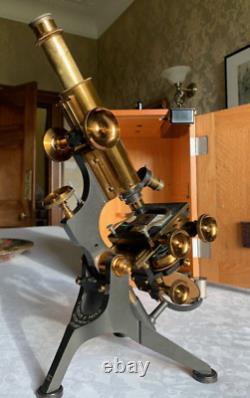

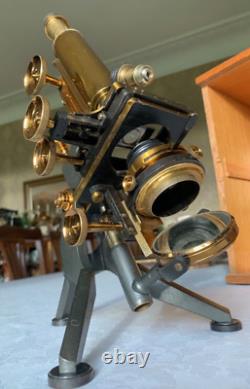

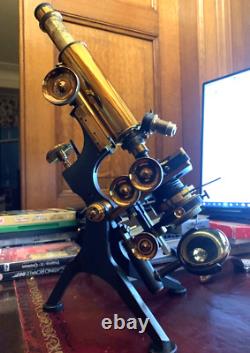
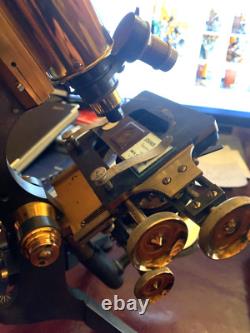



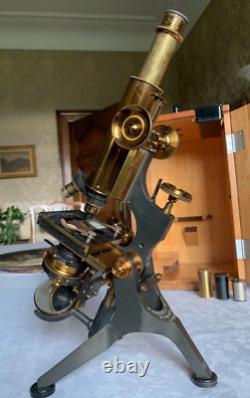

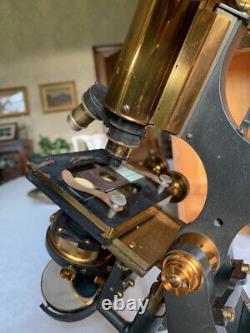
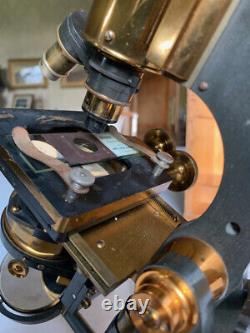
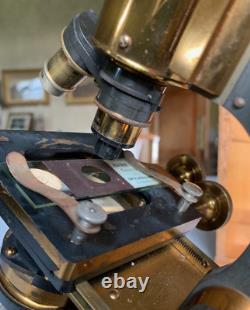

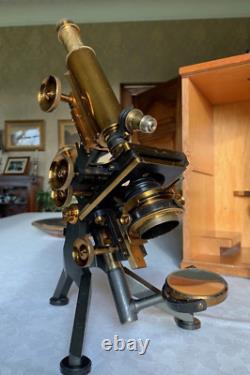

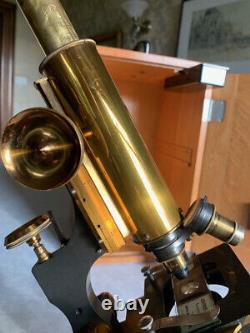
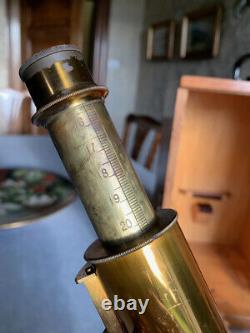

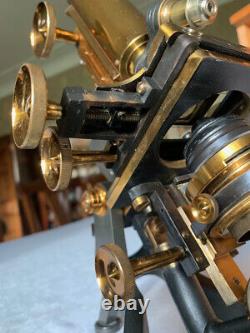
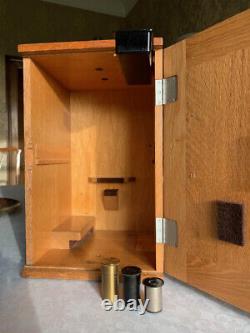

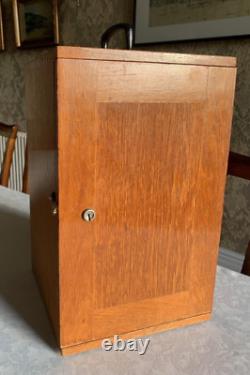

This listing is for a very well-kept original example of Watson's Edinburgh Student's Stand-H model microscope in brass. It dates to around 1906 based on its sequential Watson serial number 8677 and just pre-dates Watson's move to limited company status which occurred in 1908, so this example is marked W. Watson & Sons, 313 High Holborn, London.
The brass-work is in rather good condition for its age with hardly any spotting or tarnishing that I can see, which is surprising for an original condition example from this period and a splendid find in this condition. The anodised brass tripod and frame are also showing no signs of verdigris that I can detect, with the tripod and limb therefore having a lovely patina. The anodised brass tripod feet are all present and correct - in this period Watson used separate brass feet attached from underneath with small brass bolts. The Edinburgh model range was produced by Watson between 1887 and around 1945; its long production run giving us a firm clue regarding just how good this model of microscope was in its heyday. The Edinburgh stand was originally developed by Watson in collaboration with a professor and lecturer in bacteriology at the University of Edinburgh, hence the Edinburgh designation.With its signature rear cross-member giving that classic "H" look, nice shiny brass-work, Watson's Edinburgh model is a fine example of British optical engineering with a design and style essentially dating back to the Victorian era. Turning to the technical details, the coarse focus is via rack and pinion with the main tube holding in position well. For fine focus, this is achieved via a separate brass thumb-wheel located at the rear of the upper frame which operates an internal lever system against sprung resistance. The focusing technique being to achieve near focus with the coarse thumb-wheels, then fine-tune with the single rear thumb-wheel, which only has a fairly small range of movement via its vernier screw mechanism.
The instrument can be tilted for inclined viewing and holds in position as it should on inclination. With the optics, this Watson microscope comes fitted with a period graduated brass eyepiece draw-tube inside a brass main optical tube and there's two quality vintage eyepieces that with adequate illumination produce good images.The instrument has three period objectives and there's an older-style double turret which rotates with a positive quality feel. The objectives are as follows. 1 inch Watson in brass - approx. 5x magnification - 2/3rds inch Watson - 10x magnification.
1/6th inch Watson - 40 x magnification. (two of the objectives have brass canisters). Overall therefore, the range of magnification available with this Watson ranges from about 40x with the lowest power lens combination, up to around 400x with the highest power combination and with the benefit of good illumination. The fully mechanical stage is an original Watson item in brass with twin thumb-wheel adjusters on the right hand side of the stage, currently fitted with a pair of sprung specimen clips for holding slides steady during inclined viewing and when the axes are being moved around which work very well. The freely running x/y controls also offering fine control of specimen positioning, which is a real advantage for higher magnification work.
Turning to the sub-stage, we have a Watson Abbe-type condenser with centering controls comprising three small brass thumb-screws, which sits in a height adjustable rack and pinion mount with single-sided brass thumb-wheel to adjust the height along with a swing-out feature allowing easy swapping or maintenance of the condenser hardware. The condenser assembly also has an iris to control lighting levels and there's a 35mm swing-out carrier fitted for adding coloured, opaque of dark-field filters. Lighting is via a plano-concave mirror on a height and swing-adjustable brass support arm and gimbal, with period silvering that's in good condition, just showing some minor age-related foxing to both sides.All the instrument's controls have been lightly lubricated and operate with age-appropriate signs of wear including coarse focus, fine-focus, eyepiece draw-tube, mechanical stage, condenser rack and plano-concave mirror. This instrument presents well with lovely brass-work that catches the light, giving a nice deep golden glow. Overall, it's in fine shape for its age and period. This instrument is essentially a collectible Watson Edinburgh Stand-H model and it'll make a rather nice usable display item. It will display rather well in a library or home office setting, especially when set up with an appropriate antique slide and you'll see some photos in the listings of it set up on my desk.
There's also a solid good quality storage case with this example, which is also in fine condition for its age and is likely to be a Leitz or Zeiss case from around the 1940s/50s or thereabouts. It fits the Edinburgh-H quite well and comes with a metal carry-handle, internal lens drawer and also a lock with key missing, so it's fitted with a cupboard latch to keep the door closed. Thanks for looking - please also check out my other listings if you get the chance.
